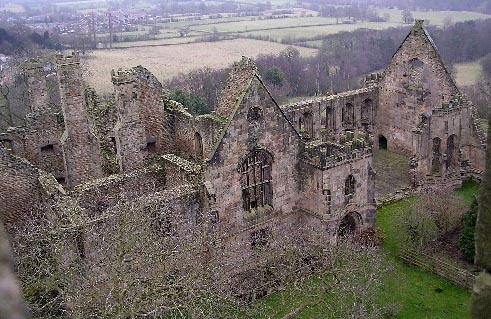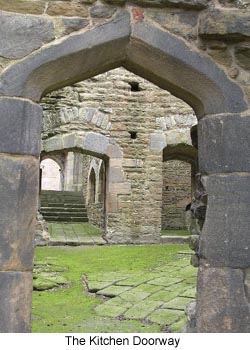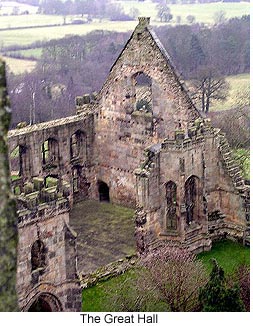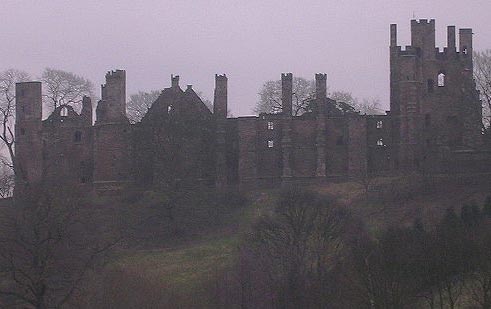Wingfield Manor: Palace and Prison
by Julia Hickey
Wingfield Manor, standing proudly at the gateway to the Peak District, is famous as the prison from which Sir Anthony Babington plotted to rescue Mary Queen of Scots. Legends of tunnels and daring meetings are still recounted here on winter evenings. The story has inspired more than one writer, the most famous being Alison Uttley, who penned A Traveller in Time, telling the story of the Babington plot to rescue Mary.

The origins of the manor are swaddled in a legal dispute to determine ownership of the land. Eventually, after a long wrangle, ownership of this windy hill was granted to Henry VI's treasurer -- Ralph, Lord Cromwell -- who promptly built himself a fortified house that reflected his power and his wealth. Wingfield's history seems to be intertwined with the fate of unhappy monarchs. In addition to the captive queen and poor, mad Henry, Wingfield saw some notoriety during the English Civil War when a garrison of royalists used the manor as a stronghold for riding out into Derbyshire on sorties. The "slighting" of Wingfield Manor seems to foreshadow the day when Charles I's head came tumbling from his shoulders.
Follow its "slighting", when many of the defensive walls were demolished, Wingfield was purchased by the Halton family (originally from Greystoke in Cumberland), who redesigned the remaining buildings before finally robbing the various ranges of dressed stone to build a new home more appropriate to the needs of 18th century gentry. The most famous member of the family and the first to own Wingfield, Immanuel Halton, set up sundials in the grounds and used the manor as a base for his astronomical observations, including the first scientific observation of an eclipse of the sun. (The church down in the village of South Wingfield contains a memorial to Immanuel.)
Today, there is a working farm at the centre of the complex of buildings and ranges. For this reason visitors are asked to respect the specified opening times, and are reminded not to stray from the designated paths and to respect the privacy of the family that lives in the farmhouse.
As treasurer to Henry VI, Lord Cromwell amassed great power and a large personal fortune. It is perhaps significant that his emblem, displayed above the main entrance to the great hall, depicts a purse. He set about transforming the hill into a home fit for a medieval lord. By the middle of the 15th century Wingfield Manor was a bustling and well fortified castle with Lord Ralph sitting at its heart like a spider in the middle of its web. In later years Mary Queen of Scots, who often complained about her numerous prisons, described the manor as a "palace". She was less complimentary about some of its other qualities!
 The tour begins in the kitchen after a short walk by the side of formidable looking walls interspersed with chimney stacks. The three great hearths, the cupboard for spices and the remains of the two bread ovens are indicators of the standard of cuisine expected by Lord Ralph. Passing through the door to the left, one gains a sense of the confined spaces and warren of rooms in which Mary Queen of Scots found herself 130 years after Lord Ralph's Manor was first inhabited. Looking up, it is possible to see the remains of great stone fireplaces set into the walls above and behind the kitchen area. Mary wasn't impressed by the medieval drafts or the medieval stench from the garderobes. She claimed that the smells made her unwell and demanded to be moved. Her gaoler and the manor's owner at that time, the Earl of Shrewsbury, felt that the stench was more likely to have been caused as a consequence of Mary's own sizeable household, her stable full of horses and the exotic pets with which she filled her time rather than the lack of plumbing in the old manor.
The tour begins in the kitchen after a short walk by the side of formidable looking walls interspersed with chimney stacks. The three great hearths, the cupboard for spices and the remains of the two bread ovens are indicators of the standard of cuisine expected by Lord Ralph. Passing through the door to the left, one gains a sense of the confined spaces and warren of rooms in which Mary Queen of Scots found herself 130 years after Lord Ralph's Manor was first inhabited. Looking up, it is possible to see the remains of great stone fireplaces set into the walls above and behind the kitchen area. Mary wasn't impressed by the medieval drafts or the medieval stench from the garderobes. She claimed that the smells made her unwell and demanded to be moved. Her gaoler and the manor's owner at that time, the Earl of Shrewsbury, felt that the stench was more likely to have been caused as a consequence of Mary's own sizeable household, her stable full of horses and the exotic pets with which she filled her time rather than the lack of plumbing in the old manor.
Moving back into the kitchen, take the middle door leading towards the great hall. Again, the first floor contains windows and fireplaces that show the wealth of Lord Ralph. Henry VI stayed in one of these rooms and his treasurer must have also enjoyed the opportunity to sit by one of the fires away from the bustle of the great hall and the ceremony that he insisted upon in his public life. The hall with its long range of windows, the bay and the oriel window were designed as a display of power and remain an impressive sight even in their ruined state. Lord Ralph would have sat on a raised dais at the far end of the hall. People entering the hall would have to walk the length of the room in order to do business with him and to beg for justice.
The far end of the hall shows some of the Halton family renovations. Originally the hall rose from the stone floor to the high ceiling -- which must have been rather smoky as there was no chimney to allow fumes from the fire to escape. The Haltons added a partition wall and a first floor. Visitors can see the sockets carved into the wall to support the wooden joists.
 The tour leads down twisting stairs and out into a sheltered garden and orchard area. A path leads visitors around by the side of a ruined range to the main gatehouse. Today a sunken path climbs the hill to the arched entrance. Here, evidently, is the road that Mary Queen of Scots must have travelled. Pass under one of the covered passages into the outer courtyard, where visitors would have been welcomed before being led into the inner courtyard. Take the opportunity to look inside the ancient barn with its massive oak beams and substantial stone flooring. This is probably the oldest building on the site and the fireplace shows that it was a human habitation at some time. One theory suggests that it was used by the masons who built Wingfield Manor.
The tour leads down twisting stairs and out into a sheltered garden and orchard area. A path leads visitors around by the side of a ruined range to the main gatehouse. Today a sunken path climbs the hill to the arched entrance. Here, evidently, is the road that Mary Queen of Scots must have travelled. Pass under one of the covered passages into the outer courtyard, where visitors would have been welcomed before being led into the inner courtyard. Take the opportunity to look inside the ancient barn with its massive oak beams and substantial stone flooring. This is probably the oldest building on the site and the fireplace shows that it was a human habitation at some time. One theory suggests that it was used by the masons who built Wingfield Manor.
Return to the crypt to find more tangible evidence of the master masons. Just inside the doorway one can see a number of mason's marks, as fresh as the day they were first made. The crypt -- or more properly, the undercroft -- is a dark and eerie place. The columns that support the roof and the buildings above spread into a vaulted roof with decorative bosses; carvings of green men with oak leaves sprouting from their mouths hide in dark corners; angels playing musical instruments wait to be discovered. Yet it was apparently a storeroom, no more, no less. Take a torch to admire the decorations and to keep at bay the shadowy figures some visitors see flitting around the columns.
After climbing the stairs at the far end and of the undercroft, you'll emerge blinking into the daylight of the inner courtyard. The most noticeable feature of the courtyard apart from Lord Ralph's crenulated entrance is an old walnut tree, gnarled with age and supported by timbers. This tree grew from another planted many centuries ago. History tells us that Sir Anthony Babington first made Mary's acquaintance when he was a page in the Earl of Shrewsbury's household. Young, romantic and Catholic, he was determined to rescue the Scottish queen. By the middle of 1586 they were engaged upon a plot that, had it been successful, would have set Mary on the throne. Legend adds to the story of Anthony and Mary by stating that the young man often went to Wingfield to visit his queen from his home at nearby Dethick. In order to gain entrance to the manor he used to disguise himself as a gypsy, and to make the disguise more convincing he stained his skin with walnut juice. The first walnut tree sprang from a nut that fell from his pocket. It's a romantic tale with a sad ending.
Sir Anthony seems idealistic, brave and a little bit impractical. There is another local legend that in order to get Mary out of Wingfield Manor, Babington dug a tunnel with the idea of coming up into Mary's suite. Given Wingfield's rocky foundations, this would have been an impressive feat of engineering . No real evidence for the existence of Babington's tunnel to Wingfield Manor has ever been found. In the late 1950's, however, workmen demolishing Crich Manor House found steps leading downwards from a room known as the Queen's Room to a passage heading towards Edge Moor. The passage was blocked. It is possible that Babington intended to use a short length of tunnel and then for Mary to make good her escape under the cover of sunken lanes shrouded by canopies of leaves. The truth is that Babington's conspiracy never stood any real chance of success. The secret service was well rehearsed in dealing with the Queen of Scots by the time that Babington conceived his plot to rescue the aging queen.
Mary was desperate to escape. Babington was not as secretive as he should have been, but then Mary was hardly discreet either. The pair exchanged letters through a system of beer barrels; in one of these Babington described Elizabeth as an "usurper" and announced that Mary should take her place. Mary agreed, advising Babington of the need of foreign support so that they could attain their ends. In so doing ensured that her death warrant would finally be written. Walsingham was well aware of the pair's method of correspondence, and had long been monitoring the letters Mary thought so secret. In August 1586 the arrests began, and by December Mary had finished the long journey that began with her birth in the palace at Linlithgow and ended in Fotheringay Castle with her execution.
Complete your visit to Wingfield by climbing the 110 steps to the top of the tower. Before beginning the climb, pause to look at the communal toilet on the ground floor. Evidence suggests that wooden seat -- with holes -- ran the length of one of the walls. More aristocratic visitors would have had their own garderobes. Some of the tall chimney-like structures are in fact chutes depositing waste immediately outside the manor's walls -- right next to the kitchen and just around the corner from the Queen's apartments. The communal toilet offered more advanced plumbing arrangements. The waste was collected in the cellar of the tower. When it was full or the smell too overpowering, some unfortunate servant was designated to clear it out. There are a number of holes in the wall for this purpose. There is also clear architectural indication of a flushing system. It is thought that there was a tank of water at the top of a large chute, the end of which can still be seen. During the cleaning process the water was emptied down the chute to help with the cleansing process. No wonder Mary felt unwell! Not that she or any other member of the Shrewsbury family would have been at Wingfield on those occasions. The whole household would pack up their furniture and hangings and travel to another of the Shrewsbury residences during the "sweetening" of the air.
From the top of the tower it is possible to see Wingfield Manor as a whole rather than as a series of rooms reminiscent of loosely linked jigsaw pieces. Across the valley, Halton Hall, built in 1774 can be viewed amid the rolling Derbyshire Countryside.

With wind whistling and the threat of rain another episode in England's turbulent past becomes readily understandable. By the time of the English Civil War Wingfield had passed from the Earl of Shrewsbury's family into the hands of the Earl of Pembroke -- who was a Parliamentarian. The manor was taken by a royalist force and used a raiding post. Up to 200 men were garrisoned in the building. Mounted on swift horses, these men rode out to bring war to the surrounding countryside. They must have been pretty successful, because in 1644 Wingfield Manor was besieged by Parliamentarians with heavy artillery. The walls leading to the kitchen door are still pockmarked by cannon fire.
Finally Wingfield Manor was captured and slighted. When a building is slighted it is rendered incapable of being used as a point of defence. Generally speaking this means that walls are torn down and towers demolished. This is exactly what happened to Wingfield.
Free parking can be found some 150 yards beyond the entrance on the right hand side of the road. The manor itself is situated on a rocky outcrop above fish ponds looking out across the fertile valley. The walk from the car to the entrance is approximately 400 yards. The path is firm but can be muddy when wet so stout shoes are recommended. Allow two hours for the visit as English Heritage provide an audio tour with thirteen different play points. There are also many features, like the ruined spiral stair, that visitors may wish to explore or photograph.
From Wingfield it is a short journey to Dethick, Anthony Babington's home. It is a pretty little village and it is still possible to see St John the Baptist's church dating from the Tudor period. There is a memorial in to the Babington conspirators here. After being taken to the tower to be tortured, they were hung, drawn and quartered at Tyburn. The old manor house, the Babington family home, is not open to the public but it has a priest hole and a stone barn dating from the 16th century decorated with the Babington coat of arms. Other locations with a link to Mary Queen of Scots not far from Wingfield Manor include Chatsworth and Hardwick Hall, both of which are worth a visit. Then, for a change of historic gear, advance into the industrial age with a visit to the tram museum or Arkwright's Mill at Cromford.
More Information:
We regret that we no longer have the resources to maintain up-to-date links and/or hours and pricing details for the various sites and attractions listed on this website. For more information about the location(s) listed above, please use your favorite search engine or visit Wikipedia.
Julia Hickey is passionate about England's heritage and particularly of Cumbria, where her husband comes from. In between dragging her family around the country to a variety of historic monuments, she works part-time as a senior lecturer at Sheffield Hallam University. She spends the rest of her week writing. In her spare time, she enjoys walking, dabbling in family history, cross-stitch, tapestry and photography.
Article and Photos © 2005 Julia Hickey
| 